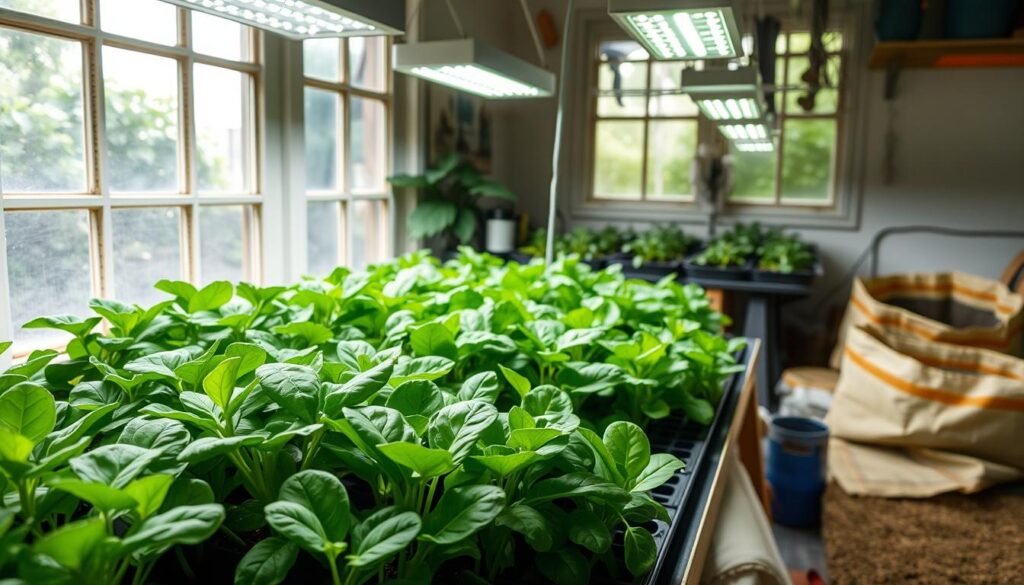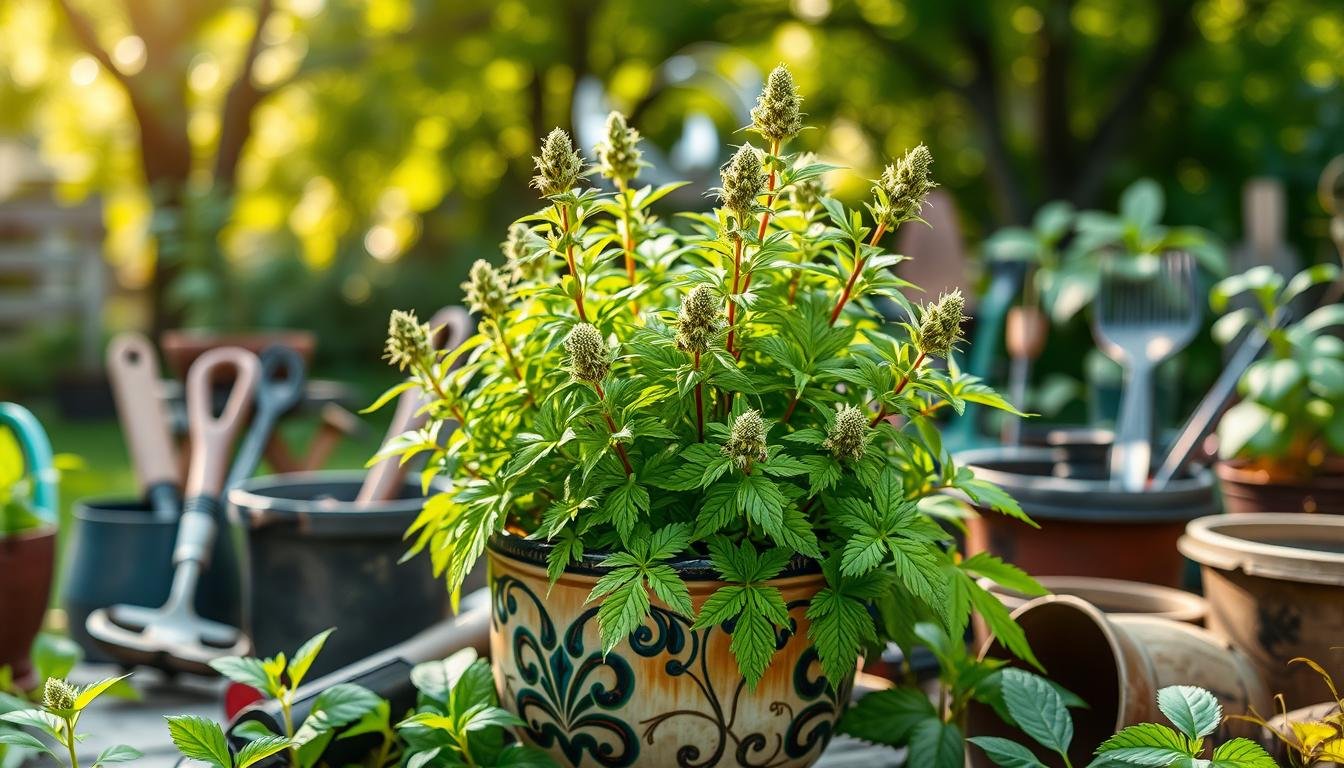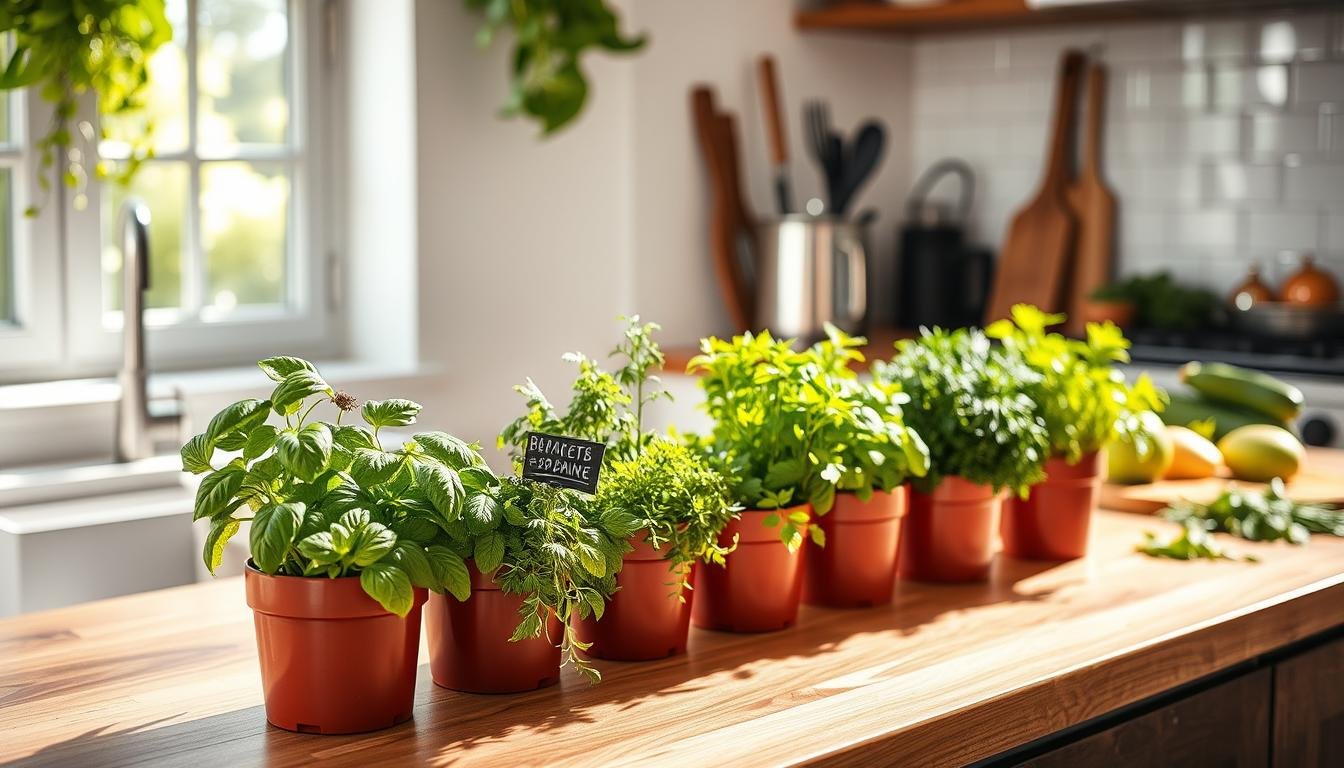Did you know 85% of Americans want to grow food indoors? Urban living spaces are getting smaller. But, the desire to garden indoors, especially with leafy greens like spinach, is increasing. Growing spinach with lights inside lets you have fresh greens all year. It makes for a healthier lifestyle, no matter the season. This guide will show you how to be successful with spinach container gardening. So, you can enjoy this nutritious vegetable throughout the year.
Key Takeaways
- Indoor gardening is becoming increasingly popular, with many seeking fresh produce.
- Spinach is an ideal candidate for container gardening indoors.
- Growing spinach under lights allows for year-round cultivation.
- Mastering indoor spinach gardening can enhance your diet and lifestyle.
- Understanding the right techniques can lead to gardening success.
Understanding the Basics of Indoor Spinach Gardening
Starting an indoor garden is a fun journey. Especially with spinach, a leafy green full of nutrition. Knowing what you need and the perks of indoor spinach growing helps you start strong.
What You Need to Get Started
To start your indoor spinach garden, you’ll need some key items. Let’s look at what’s essential:
- Containers: Pick pots with holes at the bottom. This helps avoid too much water.
- Soil: Use a potting mix that drains well and is full of nutrients for healthy spinach.
- Lighting: If you don’t get a lot of sunlight, grow lights are a great option.
- Watering can: Choose a watering can that lets you easily control water flow.
- Fertilizer: Balanced fertilizer keeps your spinach growing strong.
Benefits of Growing Spinach Indoors
Growing spinach inside has a lot of advantages. Here’s why it’s great:
- Get fresh spinach all year, no matter the weather outside.
- Stay away from pests and diseases that harm garden plants.
- Save space, perfect for smaller homes and apartments.
- Feel the joy of harvesting your own healthy greens.
Choosing the Right Variety of Spinach
Starting an indoor spinach garden? Picking the right type is key to success. Some spinach kinds do better indoors, thanks to how they grow and their toughness. Choosing popular kinds of spinach ensures a strong crop. Also, think about trying spinach microgreens for an indoor garden adventure.
Popular Spinach Varieties for Indoor Growing
For indoor gardens, the top picks are:
- Bloomsdale: Tasty leaves and heat-resistant.
- Butterflay: Smooth leaves and adapts well to different environments.
- Space: Small, perfect for tight spaces.
These spinach types are ideal for indoor gardening. They are great for anyone who loves to garden inside.
Microgreens vs. Adult Spinach: What to Choose?
Choosing between spinach microgreens and adult spinach? Each has its perks. Spinach microgreens grow in just 7-14 days and save space. Great for small places! But, grown-up spinach gives you more to eat and has a stronger taste.
So, the choice between microgreens and full-sized spinach depends on what you need. Think about space, nutrition, and how you’ll use them in cooking.
Growing Spinach Indoors Under Lights
Successful indoor spinach growth needs the right light. Understanding how much light spinach requires is key for good growth and more yield. Spinach does well with plenty of light, needing about 12 to 16 hours each day. We’ll look at the various light needs and the best lighting systems for spinach.
Light Requirements for Spinach Growth
Spinach grows best with bright, intense light. Here are important points to consider:
- Intensity: Spinach needs strong light to grow well. Aim for 200 to 600 µmol/m²/s of light.
- Light Quality: Full-spectrum lights work best. They offer a balance of wavelengths, just like the sun.
- Photoperiod: Keeping a consistent light schedule is important. Spinach prefers longer days, especially at the start.
How to Set Up Your Indoor Lighting System
Setting up an effective lighting system makes a big difference. Here’s what to do:
- First, pick the right grow lights. Your choices include:
- LED Lights: These save energy and last long, making them a top choice.
- Fluorescent Lights: Good for small areas and quite effective.
- High-Intensity Discharge (HID) Lights: Best for big setups, but they use more energy.
Following the right light requirements and selecting a suitable lighting system will boost your indoor spinach growing success. Adopting these tips will help grow healthy spinach plants you can enjoy.
Essential Tools and Supplies for Your Indoor Spinach Garden
For a successful indoor spinach garden, you need the right tools. Good containers and soil mixes are key for growth. These tips will help you start your spinach container gardening.
Best Container Options for Spinach
Choosing the right container is very important. It must have good drainage to avoid too much water. Here are the top choices:
- Plastic Pots: They are light and strong, perfect for indoors.
- Clay Pots: They look great and let roots breathe well.
- Trays: Best for growing lots of spinach, like microgreens.
- Self-Watering Containers: They keep soil moist, making care easier.
Recommended Soil Mixes for Optimal Growth
The right soil is crucial for your spinach. Pick soil mixes for spinach that have nutrients and drain well. Here are your best options:
| Type of Soil Mix | Composition | Benefits |
|---|---|---|
| Commercial Mix | Peat moss, perlite, compost | Ready to use, high quality |
| Homemade Mix | Equal parts garden soil, compost, and peat | You can adjust nutrients, saves money |
With the right supplies, such as good containers and soil, your indoor spinach garden will thrive. Enjoy growing and eating fresh spinach!
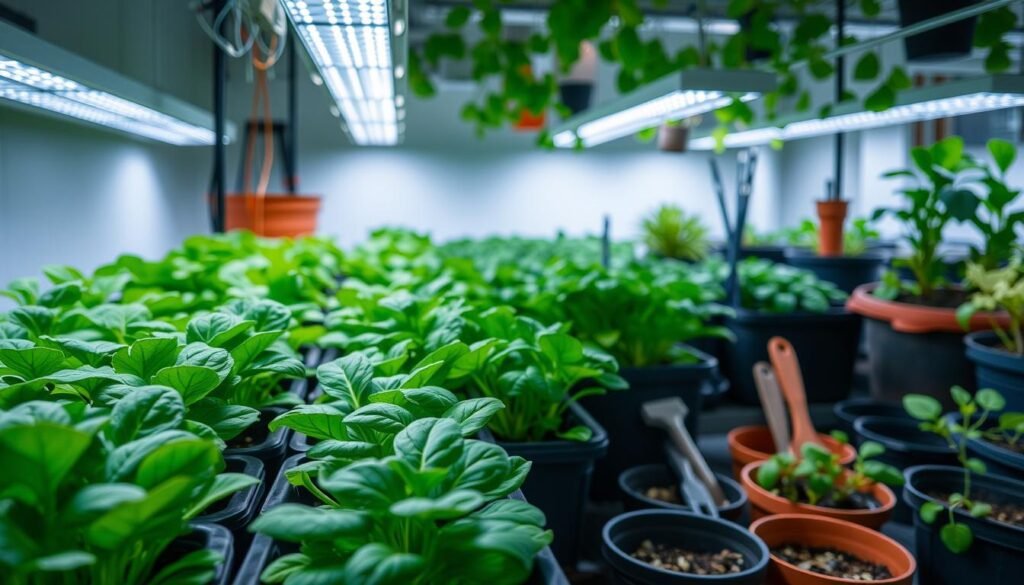
Hydroponic Spinach: An Alternative Growing Method
Have you thought about growing spinach in a unique way? Hydroponic spinach does just that. It grows without soil. This method offers lots of benefits. It’s perfect for gardeners who want to be efficient and productive.
Benefits of Hydroponics
Hydroponics is more than just a space-saver. Here’s why it’s a great choice:
- Faster Growth: Spinach grows quicker in hydroponics because it gets nutrients directly.
- Reduced Pests: It cuts down on soil-borne pests, making plants healthier.
- Efficient Water Use: This method needs 90% less water than traditional gardens.
- Lesser Space Needed: You can use vertical gardening in tiny spaces at home.
Setting Up a Hydroponic System at Home
It’s pretty easy to start a home hydroponic system. Here’s what you need to do:
- Choose the Right System: Look at Deep Water Culture, Nutrient Film Technique, or Aeroponics.
- Gather Supplies: You’ll need a reservoir, growing medium, net pots, and nutrient solutions.
- Set Up the System: Make sure your hydroponic method allows for proper water and nutrient flow.
- Maintain Regular Checks: Keep an eye on pH and nutrient levels to help your spinach thrive.
Optimal Conditions for Spinach Seed Germination
To get spinach seeds to germinate, you need the right conditions. The ideal temperature for spinach is key. Seeds do best when it’s between 65°F and 75°F. You also have to keep an eye on humidity levels for germination, aiming for 50% to 70% for strong seedlings.
Ideal Temperature and Humidity Levels
Check out this guide for the best conditions:
| Condition | Recommended Level |
|---|---|
| Temperature | 65°F – 75°F |
| Humidity | 50% – 70% |
Step-by-Step Guide for Seed Germination
Here’s how to germinate spinach seeds successfully:
- Pick high-quality seeds for the best start.
- Plant seeds in soil that drains well, about 1 inch deep.
- Make sure the soil stays moist, but not too wet.
- Watch the temperature and humidity, keeping them at the ideal level for spinach. Adjust as needed.
- In about a week, check if the seeds have sprouted. Keep taking care of them until they’re ready to move outside.
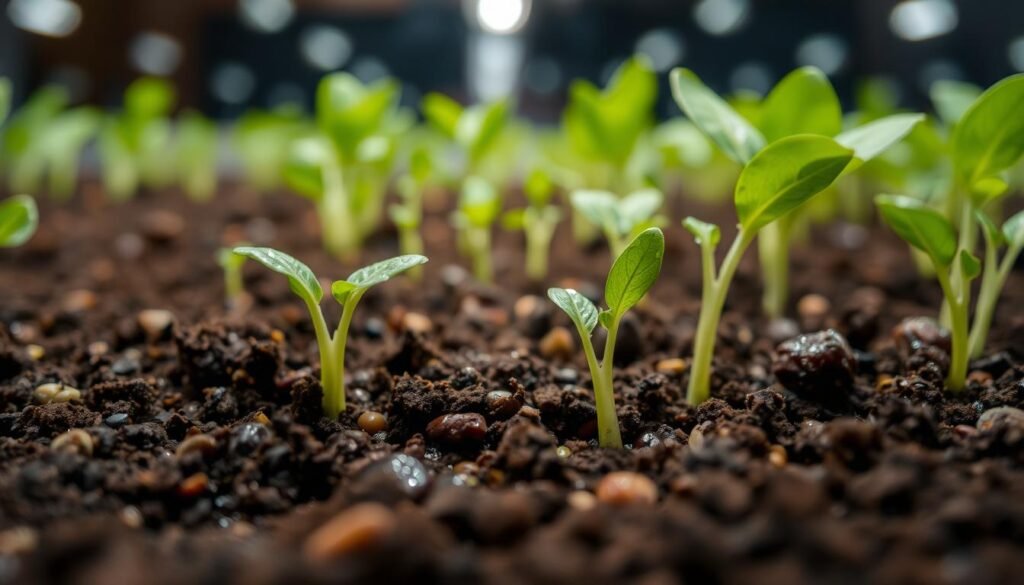
Maintaining Your Indoor Spinach Garden
Keeping your indoor spinach garden thriving requires regular care. You should water and fertilize it properly. This helps your spinach grow healthy and strong.
Watering Tips and Tricks
To keep your indoor spinach healthy, knowing how to water it right is key. Spinach likes to stay moist but doesn’t like too much water. Follow these tips:
- Check the soil moisture with your finger; if it feels dry an inch below the surface, it’s time to water.
- Water early in the day to prevent excessive evaporation and fungal diseases.
- Use a watering can with a narrow spout for targeted watering at the base of the plants.
- Consider using a self-watering pot for more consistent moisture levels.
Fertilization and Nutrient Needs
Feeding your spinach the right nutrients is vital for its growth. Understanding its nutritional needs is the first step. Here’s how to do it:
- Start with a balanced fertilizer when plants are about four inches tall.
- Apply a nitrogen-rich fertilizer every few weeks to promote leafy growth.
- Monitor for yellowing leaves, which may indicate nutrient deficiency.
- Consider organic options like compost or worm castings for a nutrient boost.
Using LED Grow Lights for Spinach
LED grow lights are a great choice for growing spinach indoors. They help the plants grow better and stay healthy. Knowing which LED lights to use and how long to keep them on is key for the best results.
Why Choose LED Lights?
LED lights are better than old-school lights for a few reasons. They save energy and last longer. Here are the main benefits:
- Energy Efficiency: They use less power, which saves money over time.
- Optimized Light Spectrum: These lights offer the right kind of light for spinach to do photosynthesis and grow.
- Low Heat Emission: LEDs don’t make much heat, so you can put them close to the plants without harm.
Proper Light Duration for Spinach Plants
How long you light up spinach makes a big difference. They do best with 12 to 16 hours of light and 8 to 12 hours of dark each day. This schedule helps them grow large, healthy leaves. Changing the light time based on the plant’s stage can make them even better.
Creating a Spinach Grow Tent for Optimal Growth
Setting up a tent for growing spinach is great for indoor gardeners. It lets you control the temperature and humidity. This is key for helping spinach grow well. With the right setup, your plants can be healthy and vibrant.
When setting up your grow tent, think about these things:
- Size: Pick a tent that fits your needs. Make sure it’s big enough so plants aren’t too close.
- Ventilation: Good airflow is important. Add exhaust fans and vents to keep air moving. This helps avoid too much heat and keeps plants happy.
- Lighting: Use good lights for spinach. LED lights are a good choice. They provide the light plants need to grow strong.
A grow tent improves temperature control and reduces pest problems. It keeps plants safe from outside dangers. When setting up your tent, include these elements for a successful spinach garden.
| Consideration | Importance | Tips |
|---|---|---|
| Size | Ensures plants have enough space to grow | Choose dimensions based on expected yield |
| Ventilation | Maintains air quality and temperature | Use fans and vents to facilitate airflow |
| Lighting | Supports photosynthesis and growth | Opt for full-spectrum LED lights |
By paying attention to these details, your spinach tent will be perfect for growing. You’ll be able to enjoy fresh spinach all year.
Troubleshooting Common Issues in Indoor Spinach Gardening
Indoor spinach gardening can face several challenges that impact the health and yield of plants. Knowing how to spot pests and diseases is key for good pest control and stopping disease. Checking your plants regularly for signs of trouble helps you fix problems early.
Identifying Pests and Diseases
Some typical indoor spinach gardening problems are pests and diseases like downy mildew. Here are signs to look for:
- Pests: Check for small bugs such as aphids or spider mites on the leaves. Yellowing leaves or webbing shows there might be bugs living there.
- Diseases: Spots on the leaves, powdery mildew, and plants wilting could mean there are diseases present.
Solutions for Common Problems
Using smart strategies can help fight pest management issues and boost disease prevention. Try these tips:
- Regular Monitoring: Look over your plants at least once a week to spot any early signs of trouble.
- Organic Treatments: Apply neem oil or insecticidal soaps for pests, which are safe for the planet.
- Proper Air Circulation: Keep enough space between your plants. This cuts down humidity and disease risk.
- Sanitize Equipment: Regularly clean your tools and pots to avoid spreading diseases.
- Rotate Crops: Move your spinach plants around sometimes to keep soil issues at bay.
| Problem | Symptoms | Solution |
|---|---|---|
| Aphid Infestation | Yellowing leaves, sticky residue | Use insecticidal soap or neem oil |
| Downy Mildew | White spots on leaves, wilting | Improve air circulation, remove affected leaves |
| Leaf Spot | Brown spots on leaves | Avoid overhead watering, use fungicides |
Handling indoor spinach gardening problems is doable with careful watching and the right methods. A flourishing indoor garden gives you fresh spinach and makes gardening rewarding.
Harvesting and Enjoying Your Spinach
Knowing when and how to pick spinach is key for good growth. Spinach is usually ready 6 weeks after planting. Look for leaves that are big enough. It’s best to cut the outer leaves with clean shears. Leave the inner ones to grow more. This way, you get more leaves and keep the plant happy.
How to Harvest Spinach
Harvest your spinach in the early morning for the best freshness. Take off just one-third of the leaves at a time. This helps new ones grow back. Be gentle to avoid hurting the leaves. Wash them with cool water and dry them gently after picking. Then, keep them in the fridge to stay crisp.
Recipes and Ideas for Using Fresh Spinach
After picking your spinach, it’s time to be creative in cooking! You can make so many dishes. Try sautéing it with garlic and olive oil, or adding it to smoothies. Spinach is great in omelets, pasta, and even on pizza. Enjoy the fresh taste of your spinach in these dishes.
